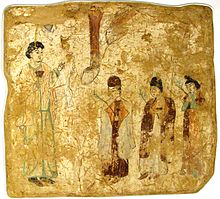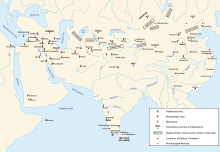Nestorianism
Nestorianism is the christological doctrine that divine and human natures are divided and unmixed in the person of Jesus Christ , and thus a form of the doctrine of two natures . It is named after Nestorius , who was Patriarch of Constantinople from 428 to 431 and represented it significantly. It was heavily criticized by Cyril of Alexandria in particular , and the doctrine was condemned as heresy at the Council of Ephesus in 431 and the Second Council of Constantinople in 553 . Only the Assyrian Church of the East then still represented the Nestorian doctrine, which is why it is also known as the Nestorian Church . One of the last group of believers to be disbanded through persecution are the mountain nestorians , who settled in the mountains of today's Turkish province of Hakkari until their exodus in 1915 .
As a reaction to Nestorianism, the oppositely oriented Monophysitism (also Miaphysitism ) arose , according to which Jesus was completely divine and had only one divine nature. This was rejected at the Council of Chalcedon in 451 and a different doctrine of two natures was adopted, according to which the divine and human nature of Christ stand side by side, unmixed and unaltered , undivided and unseparated, i.e. not divided as in Nestorianism.
In Nestorianism, Mary is only venerated as the "Theotokos", but not as the Theotokos .
Content of teaching

In the christological discussions of the 5th century, Nestorianism takes the opposite position to miaphysitism .
Nestorianism is essentially defined from the anathemas of Cyril of Alexandria and the Council of Ephesus. According to Cyril, the main point of Nestorianism is the teaching that in Jesus Christ there was a person with a divine nature and a person with a human nature. Every assigned attribute and every act of the incarnated Christ can be assigned to one of these persons. Both persons are only connected by the bond of love.
However, neither Nestorius himself nor the representatives of the Antiochene School accused as his followers actually taught this view. Rather, they took positions, albeit partly in unfortunate formulations, which finally came to bear in the Council of Chalcedony in 451. The problem was that Nestorius the use of the attribute Theotokos ( Mother of God ), an attribute of pagan goddesses regarding Maria has the mother of Jesus refused. It would be better to speak of a bearer of the Christ or the birth of man.
Even the Assyrian Church of the East, often referred to as Nestorian by the Orthodox and Roman Catholic Church, has never represented the alleged teachings, so that Nestorianism can only be spoken of as a heresiological construct, not of a historical movement. The Miaphysite churches have extended the reproach of Nestorianism to the Chalcedonians , i.e. Orthodox and Catholics.
Spread
Nestorius was Patriarch of Constantinople until 431. The doctrine advocated by him was condemned at the Council of Ephesus in 431.
Many of his followers eventually emigrated to the Sassanid Empire , where at that time there were already a relatively large number of Christians (even if they never formed the majority). The so-called chronicle of Seert contains important information . The church that was being formed in Persia was often referred to as the Nestorian Church - but it had little in common with Nestorius and should therefore be better described as the East Syrian Church or the Assyrian Church of the East. From now on, however, it was hostile to the Roman Empire, so that the Persian kings who were hostile to the Roman Empire were much more benevolent towards the Persian Christians, even if there were occasional attacks. Because the old centers of Constantinople , Alexandria and Antioch on the Orontes were not accessible, Edessa , today's Urfa (or Şanlıurfa ) in southeast Turkey, became the “Nestorian” center. The seat of the Catholicos was Ctesiphon .
Despite some handicaps, missionary work could develop on the Silk Road , which also led through Edessa ( Johannes de Plano Carpini ). The traders took not only goods but also their religion and beliefs to the east. Christian communities emerged among the Turkic peoples in Central Asia and in Xinjiang (today in the northwest of the People's Republic of China). Sometimes entire peoples became Christian. In 779 a monument was erected in western China that reported the introduction of the great "shining religion from Daqin (Rome)" - the so-called Nestorian stele can be found in today's Xi'an (西安). Traces of this missionary activity have also been discovered in Japan (documented in the 9th century) and on Sumatra .
The heyday of this church in the 13th century was soon followed by the almost complete destruction by Timur Lenk (or Tamerlan) in the 14th century. The Jesuit priest Matteo Ricci came across remnants of Christianity in China in the 16th century. When the above-mentioned Nestorian stele was found in 1625, it was an explanation of why Matteo Ricci could find Christian elements in his missionary work. But at the same time this discovery invalidated the accusation of the Chinese that the missionaries were bringing something completely new, completely foreign to the Middle Kingdom. The stele proved that the Christian faith had taken root in China long ago.
In the Mongolian capital Karakorum there was a Nestorian church around 1250. It can therefore be assumed that Nestorian Christianity was a widespread belief in the Mongol Empire until around 1250.
Others
- James Hilton addresses the spread of Nestorianism in Central Asia in the novel The Lost Horizon .
- The Nestorians are mentioned in the 2007 film Ulzhan - The Forgotten Light by Volker Schlöndorff . In the second half of the film, Ms. Ulzhan asks the French Charles what he is looking for on Mount Khan Tengri , whereupon he replies: “I am looking for the treasure of the Nestorians” and explains the relevant connections.
literature
- Wilhelm Baum, Dietmar W. Winkler: The Apostolic Church of the East. History of the so-called Nestorians . Klagenfurt 2000.
- Wolfgang Hage: Nestorian Church. In: Theological Real Encyclopedia . Vol. 24 (1994), pp. 264-276 (with further literature)
- Wassilios Klein: Nestorian Christianity on the trade routes through Kyrgyzstan up to the 14th century ; Silk Road Studies 3; Turnhout 2000
See also
Web links
- Link list
- De Babylone à Pékin, l'expansion de l'Église nestorienne en Chine par Joseph Yacoub, Professeur de sciences politiques à l'université catholique de Lyon.
Individual evidence
- ^ Ludwig Ott : Outline of Catholic Dogmatics , 11th edition, Bonn 2005, ISBN 3-936741-25-5

